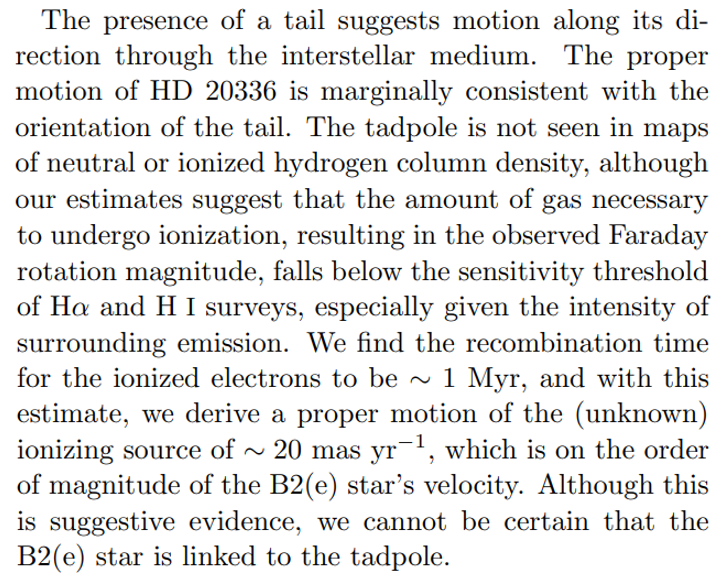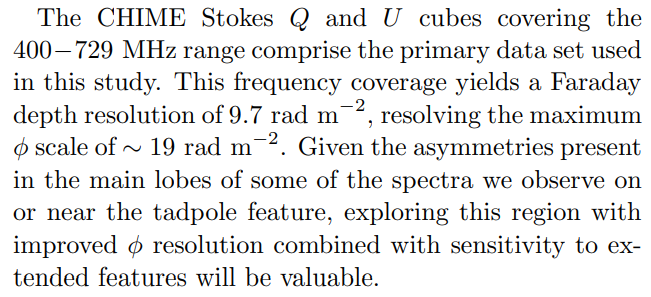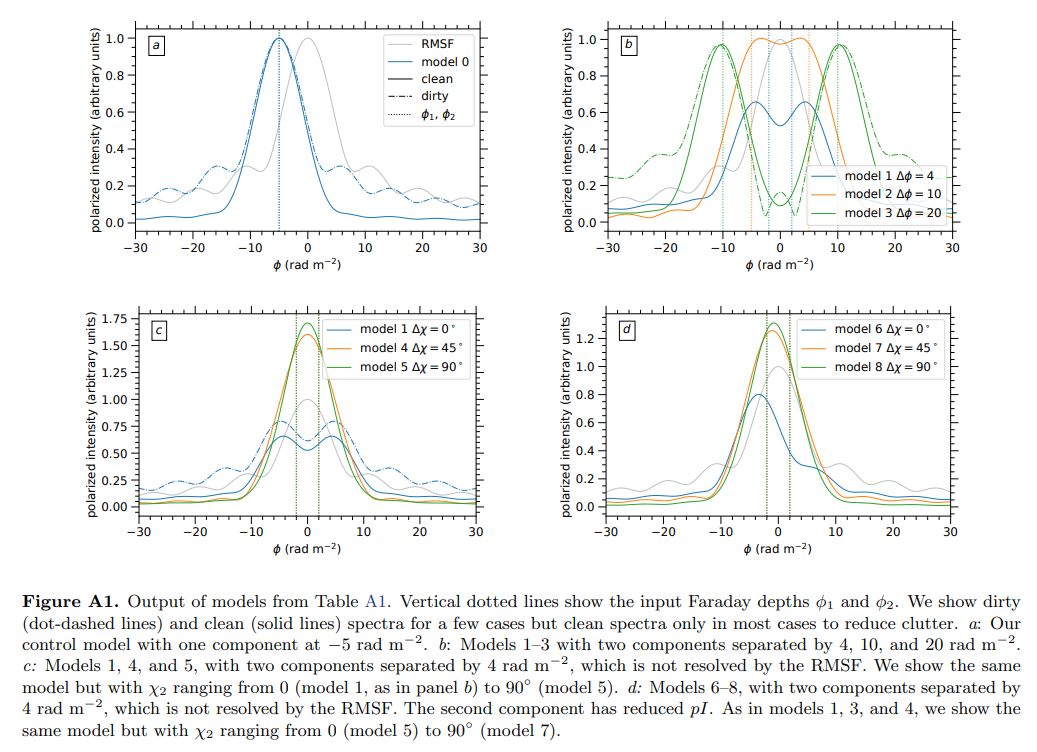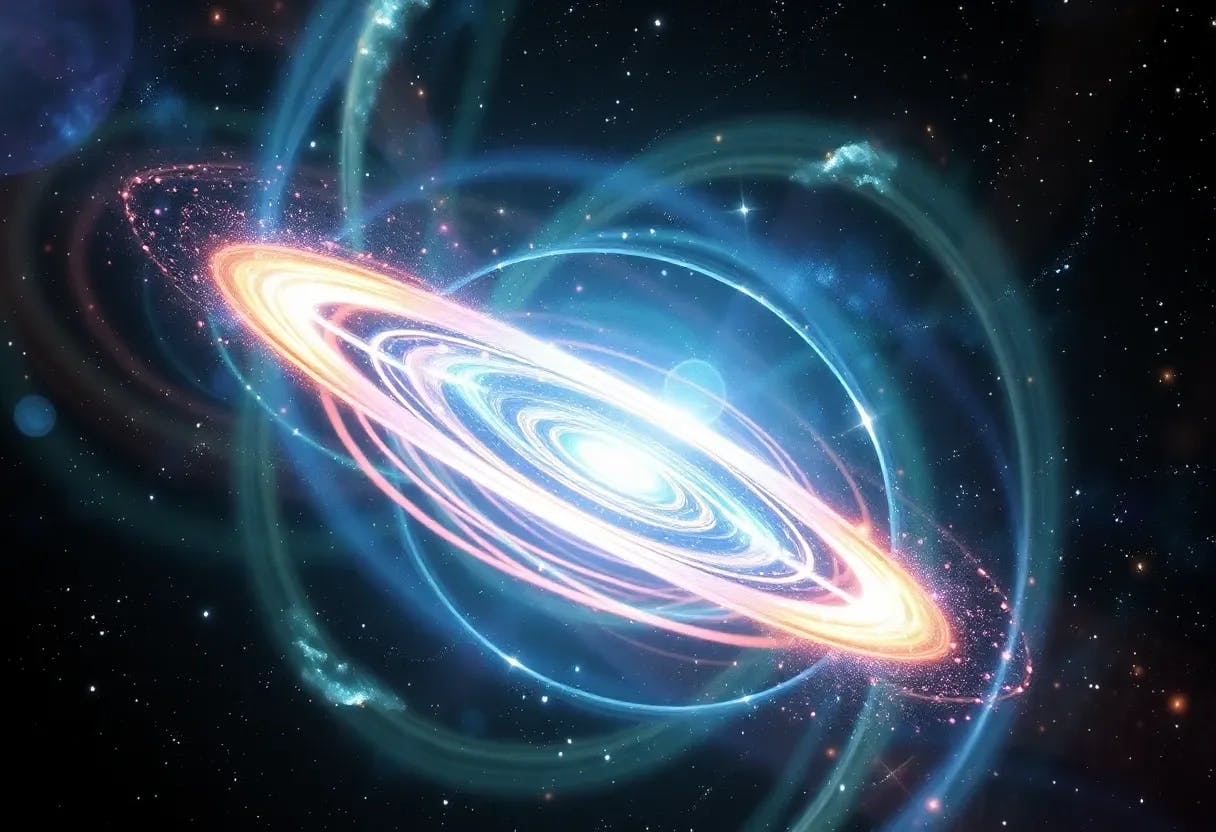Table of Links
Abstract and 1 Introduction
-
Faraday Rotation and Faraday Synthesis
-
Dara & Instruments
3.1. CHIME and GMIMS surveys and 3.2. CHIME/GMIMS Low Band North
3.3. DRAO Synthesis Telescope Observations
3.4. Ancillary Data Sources
-
Features of the Tadpole
4.1. Morphology in single-frequency images
4.2. Faraday depths
4.3. Faraday complexity
4.4. QU fitting
4.5. Artifacts
-
The Origin of the Tadpole
5.1. Neutral Hydrogen Structure
5.2. Ionized Hydrogen Structure
5.3. Proper Motions of Candidate Stars
5.4. Faraday depth and electron column
-
Summary and Future Prospects
APPENDIX
A. RESOLVED AND UNRESOLVED FARADAY COMPONENTS IN FARADAY SYNTHESIS
B. QU FITTING RESULTS
REFERENCES
6. SUMMARY AND FUTURE PROSPECTS
In this paper, we have presented the first polarization maps from CHIME in what will be a component of the GMIMS low band north all-sky survey. The wide bandwidth at relatively low frequencies (400−729 MHz) gives us a Faraday depth resolution which is roughly half the largest scale we are sensitive to, enabling investigation of Faraday complexity. We analyzed a relatively small region of the sky where the emission is bright and instrumental properties are best understood; in future work, we will expand the use of CHIME data to analyze the large-scale structure of the Galactic magnetic field.


In the longer term, we will be able to combine ϕ resolution and improved spatial resolution with the advent of the upgraded DRAO ST, which will cover 400 − 1800 MHz at 1′ resolution (compared to the single frequency channel available from the current ST). The single-channel 1′ -resolution χ map from the DRAO ST+EMLS in Figure 5 already reveals an abundance of structures on scales much smaller than the size of the tadpole, and investigating these in ϕ space with high resolution may provide further insights into the nature of the overall structure. Other future studies may also include exploring potential correlations between the tadpole Faraday structure and thermal dust emission features in three-dimensional dust maps.
There are three factors in this study that CHIME makes possible. First, for the purpose of this study, CHIME is effectively a large single antenna, with sensitivity to large structures, coupled with better angular resolution than the single antennas that have been used for polarimetry in this frequency range. Second, the wide bandwidth and many frequency channels enable Faraday synthesis with ϕmax−scale ≈ 2δϕ, comfortably resolving the maximum scale. Third, the polarized sky is Nyquist sampled. This powerful combination has revealed extended and Faraday complex structure in G137+7, a region that has been a curiosity for six decades.
Data availability: FITS files containing the CHIME data products, Stokes I, Q, U, and V as a function of frequency and Faraday depth for the regions shown in this paper, are available through the Canadian Astronomical Data Centre (CHIME & GMIMS collaborations 2024).
This paper relies on observations obtained using telescopes located at the Dominion Radio Astrophysical Observatory, which is located on the traditional, ancestral, and unceded territory of the syilx people. We benefit enormously from the stewardship of the land by the syilx Okanagan Nation and the radio frequency interference environment protection work by the syilx Okanagan Nation and DRAO. We acknowledge DRAO staff, especially K. Phillips and B. Robert, for their work on the site and the telescopes used in this work. DRAO is a national facility operated by the National Research Council Canada. CHIME is funded by grants from the Canada Foundation for Innovation (CFI) 2012 Leading Edge Fund (Project 31170), the CFI 2015 Innovation Fund (Project 33213), and by contributions from the provinces of British Columbia, Quebec, and Ontario. Additional support was provided by the University of British Columbia, McGill University, and the University of Toronto. CHIME also benefits from several NSERC Discovery Grants, including RGPIN-2020- 05035 and 569654. This research was enabled in part by support provided by the Digital Research Alliance of Canada.
A.S.H. and A.O. acknowledge Interstellar Institute’s program “II6” and the Paris-Saclay University’s Institut Pascal for hosting discussions that nourished the development of the ideas behind this work, especially with R. A. Benjamin. We thank R. Mckinven for useful discussions about instrumental polarization in CHIME/FRB data. We also acknowledge helpful discussions with W. Raja. We thank the anonymous referee for a careful and constructive report which led to an improved paper.
N.M. was supported by an Undergraduate Research Award from UBC Okanagan and an NSERC Undergraduate Student Research Award. A.O. is partly supported by the Dunlap Institute at the University of Toronto. A.B. acknowledges financial support from the INAF initiative “IAF Astronomy Fellowships in Italy”, grant name MEGASKAT. M. Haverkorn acknowledges funding from the European Research Council (ERC) under the European Union’s Horizon 2020 research and innovation programme (grant agreement No 772663). We acknowledge the support of NSERC, funding reference number 569654. K.W.M. holds the Adam J. Burgasser Chair in Astrophysics and is supported by NSF grants (2008031, 2018490). M.T. is supported by the Banting Fellowship (Natural Sciences and Engineering Research Council Canada) hosted at Stanford University.

:::info
Authors:
(1) Nasser Mohammed, Department of Computer Science, Math, Physics, & Statistics, University of British Columbia, Okanagan Campus, Kelowna, BC V1V 1V7, Canada and Dominion Radio Astrophysical Observatory, Herzberg Research Centre for Astronomy and Astrophysics, National Research Council Canada, PO Box 248, Penticton, BC V2A 6J9, Canada;
(2) Anna Ordog, Department of Computer Science, Math, Physics, & Statistics, University of British Columbia, Okanagan Campus, Kelowna, BC V1V 1V7, Canada and Dominion Radio Astrophysical Observatory, Herzberg Research Centre for Astronomy and Astrophysics, National Research Council Canada, PO Box 248, Penticton, BC V2A 6J9, Canada;
(3) Rebecca A. Booth, Department of Physics and Astronomy, University of Calgary, 2500 University Drive NW, Calgary, Alberta, T2N 1N4, Canada;
(4) Andrea Bracco, INAF – Osservatorio Astrofisico di Arcetri, Largo E. Fermi 5, 50125 Firenze, Italy and Laboratoire de Physique de l’Ecole Normale Superieure, ENS, Universit´e PSL, CNRS, Sorbonne Universite, Universite de Paris, F-75005 Paris, France;
(5) Jo-Anne C. Brown, Department of Physics and Astronomy, University of Calgary, 2500 University Drive NW, Calgary, Alberta, T2N 1N4, Canada;
(6) Ettore Carretti, INAF-Istituto di Radioastronomia, Via Gobetti 101, 40129 Bologna, Italy;
(7) John M. Dickey, School of Natural Sciences, University of Tasmania, Hobart, Tas 7000 Australia;
(8) Simon Foreman, Department of Physics, Arizona State University, Tempe, AZ 85287, USA;
(9) Mark Halpern, Department of Physics and Astronomy, University of British Columbia, 6224 Agricultural Road, Vancouver, BC V6T 1Z1 Canada;
(10) Marijke Haverkorn, Department of Astrophysics/IMAPP, Radboud University, PO Box 9010, 6500 GL Nijmegen, The Netherlands;
(11) Alex S. Hill, Department of Computer Science, Math, Physics, & Statistics, University of British Columbia, Okanagan Campus, Kelowna, BC V1V 1V7, Canada and Dominion Radio Astrophysical Observatory, Herzberg Research Centre for Astronomy and Astrophysics, National Research Council Canada, PO Box 248, Penticton, BC V2A 6J9, Canada;
(12) Gary Hinshaw, Department of Physics and Astronomy, University of British Columbia, 6224 Agricultural Road, Vancouver, BC V6T 1Z1 Canada;
(13) Joseph W. Kania, Department of Physics and Astronomy, West Virginia University, P.O. Box 6315, Morgantown, WV 26506, USA and Center for Gravitational Waves and Cosmology, West Virginia University, Chestnut Ridge Research Building, Morgantown, WV 26505, USA;
(14) Roland Kothes, Dominion Radio Astrophysical Observatory, Herzberg Research Centre for Astronomy and Astrophysics, National Research Council Canada, PO Box 248, Penticton, BC V2A 6J9, Canada;
(15) T.L. Landecker, Dominion Radio Astrophysical Observatory, Herzberg Research Centre for Astronomy and Astrophysics, National Research Council Canada, PO Box 248, Penticton, BC V2A 6J9, Canada;
(16) Joshua MacEachern, Department of Physics and Astronomy, University of British Columbia, 6224 Agricultural Road, Vancouver, BC V6T 1Z1 Canada;
(17) Kiyoshi W. Masui, MIT Kavli Institute for Astrophysics and Space Research, Massachusetts Institute of Technology, 77 Massachusetts Ave, Cambridge, MA 02139, USA and Department of Physics, Massachusetts Institute of Technology, 77 Massachusetts Ave, Cambridge, MA 02139, USA;
(18) Aimee Menard, Department of Computer Science, Math, Physics, & Statistics, University of British Columbia, Okanagan Campus, Kelowna, BC V1V 1V7, Canada and Dominion Radio Astrophysical Observatory, Herzberg Research Centre for Astronomy and Astrophysics, National Research Council Canada, PO Box 248, Penticton, BC V2A 6J9, Canada;
(19) Ryan R. Ransom, Dominion Radio Astrophysical Observatory, Herzberg Research Centre for Astronomy and Astrophysics, National Research Council Canada, PO Box 248, Penticton, BC V2A 6J9, Canada and Department of Physics and Astronomy, Okanagan College, Kelowna, BC V1Y 4X8, Canada;
(20) Wolfgang Reich, Max-Planck-Institut fur Radioastronomie, Auf dem Hugel 69, 53121 Bonn, Germany;(21) Patricia Reich, 16
(22) J. Richard Shaw, Department of Physics and Astronomy, University of British Columbia, 6224 Agricultural Road, Vancouver, BC V6T 1Z1 Canada
(23) Seth R. Siegel, Perimeter Institute for Theoretical Physics, 31 Caroline Street N, Waterloo, ON N25 2YL, Canada, Department of Physics, McGill University, 3600 rue University, Montreal, QC H3A 2T8, Canada, and Trottier Space Institute, McGill University, 3550 rue University, Montreal, QC H3A 2A7, Canada;
(24) Mehrnoosh Tahani, Banting and KIPAC Fellowships: Kavli Institute for Particle Astrophysics & Cosmology (KIPAC), Stanford University, Stanford, CA 94305, USA;
(25) Alec J. M. Thomson, ATNF, CSIRO Space & Astronomy, Bentley, WA, Australia;
(26) Tristan Pinsonneault-Marotte, Department of Physics and Astronomy, University of British Columbia, 6224 Agricultural Road, Vancouver, BC V6T 1Z1 Canada;
(27) Haochen Wang, MIT Kavli Institute for Astrophysics and Space Research, Massachusetts Institute of Technology, 77 Massachusetts Ave, Cambridge, MA 02139, USA and Department of Physics, Massachusetts Institute of Technology, 77 Massachusetts Ave, Cambridge, MA 02139, USA;
(28) Jennifer L. West, Dominion Radio Astrophysical Observatory, Herzberg Research Centre for Astronomy and Astrophysics, National Research Council Canada, PO Box 248, Penticton, BC V2A 6J9, Canada;
(29) Maik Wolleben, Skaha Remote Sensing Ltd., 3165 Juniper Drive, Naramata, BC V0H 1N0, Canada.
:::
:::info
This paper is available on arxiv under CC BY 4.0 DEED license.
:::










